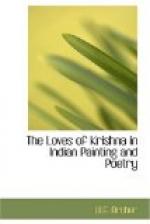When the lover arrives at dawn, having failed to come in the night, the girl (another nayika, ‘one who has been deceived’) upbraids Krishna for wandering about like a crow, picking up worthless grains of rice, wasting his hours in bad company and ruining houses by squatting in them like an owl.
Similarly when a married girl sits longing for her husband’s return, her companion comments not on an ordinary husband’s conduct but on that of Krishna. ’He said he would not be long. “I shall be back,” he said, “as soon as I have had my meal.” But now it is hours since he went. Why does he sit beside them and no one urge him to go? Does he know that her eyes are wet with tears, that she is crying her heart out because he does not come?’
Krishna, in fact, is here regarded as resuming in himself all possible romantic experiences. He is no longer merely the cowherd lover or the hero prince, the central figure of a sacred narrative. Neither is he merely or only the lover of Radha. He is deemed to know love from every angle and thus to sanctify all modes of passionate behaviour. He is love itself.
Such a development concludes the varied phases through which the character of Krishna has passed. The cowherd lover supersedes the hero prince. Radha becomes all in all, yet touches of Krishna’s princely majesty remain throughout. Even as a cowherd Krishna shows an elegance and poise which betrays his different origin. And in the Rasika Priya it is once again his courtly aura which determines his new role. A blend of prince and cowherd, Krishna ousts from poetry the courtly lovers who previously had seemed the acme of romance. Adoration of God acquires the grace and charm of courtly loving, passionate sensuality all the refinement and nobility of a spiritual religion. It is out of all these varied texts that the Krishna of Indian painting now emerges.
[Footnote 64: Plate 28.]
[Footnote 65: Note 21.]
VI
THE KRISHNA OF PAINTING
Indian pictures of Krishna confront us with a series of difficult problems. The most exalted expressions of the theme are mainly from Kangra, a large Hindu state within the Punjab Hills.[66] It was here that Krishna, the cowherd lover, was most fully celebrated. Pictures were produced in large numbers and the Kangra style with its delicate refinement exactly mirrored the enraptured poetry of the later cult. This painting was due entirely to a particular Kangra ruler, Raja Sansar Chand (1775-1823)—his delight in painting causing him to spare no cost in re-creating the Krishna idyll in exquisite terms. Elsewhere, however, conditions varied. At the end of the sixteenth century, it was not a Hindu but a Muslim ruler who commissioned the greatest illustrations of the story. In the seventeenth and eighteenth centuries, Hindu patrons were the rule but in certain states it was junior members of the ruling family




